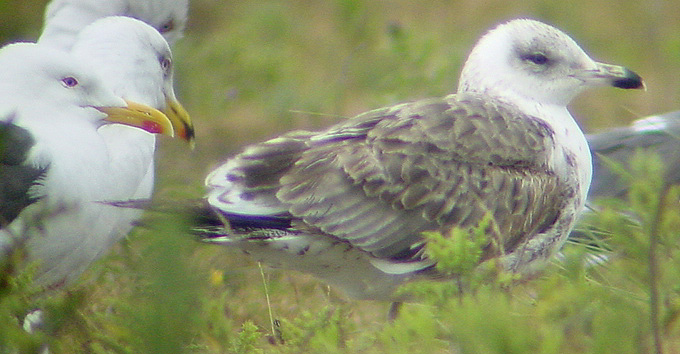Photo 8: LBBG 2cy, June 17 2001,
Reebok Maasvlakte, the Netherlands.
A third type 2cy LBBG (intermedius type), which very recently (on
the wintering grounds?) moulted the entire tail in one
wave to second generation (exactly as this
2cy at Etaples). Colour of head and under-parts is predominantly white,
with fine streaks on the head (around the eye) and smudgy patches running from
the collar down along the sides of the breast to the flanks. Neat chevrons are
sparsely on the under-tail coverts.
This is an example of extreme moult strategy, as almost the entire upper-parts
are in 2nd generation now and most feathers are worn. This individual
moulted already the plumage before heading north.
In the primaries, P1-P2 are replaced, P3 is missing, P4-P10 are juvenile and
primary moult is slightly delayed compared to typical Dutch LBBG in 2cy.
Greater covert moult progresses slowly (leaving second generation
coverts already with worn fringes on the inner coverts). Moult started at the
second inner greater covert and now reaches #10 (counted from the body), which
is plain dark grey. Greater covert #1 is growing and grey as well, the outer
coverts from #11 outwards (downwards on the folded wing) are still juvenile,
plain dark brown without a fringe.
Median covert moult arrived at #12, where the same applies as in the greater
coverts, though #2-5 are distinctly more abraded.
The carpal edge (the outer lesser coverts) is still juvenile; other lesser
coverts are old second generation. The pattern on both coverts and
scapulars is relatively simple: an accentuated shaft streak on a plain brown-grey
base.
The scapular coverts show a white tip and are visible at the centre of the back.
The upper three tertials are old and very abraded second generation
feathers, while the lower three have been replaced recently.
On the picture, the legs are hardly visible, but in the field, the tibia were
distinctly blue-grey.
The bill has a yellow hint on the basal part and a white tip on both mandibles.
Not many 2cy arrive from the wintering grounds with old body and wing-feathers. Last year, some of these intermedius types were encountered as
well (see "2cy LBBG in May") and it's this type
of birds which may resemble more eastern races such as fuscus and heuglini.
These intermedius LBBG (as they presumably are; at least they do not
represent the common widespread 2cy plumage of local Dutch intergrades) may show
an equal advanced moult on returning from wintering grounds.
Some 2cy LBBGs seem to replace all feathers at once in late spring (such as this
individual at Le Portel in May) but here, moult seems to have taken place at
least more than one month ago, as all the coverts show wear in the fringes. This
wear leaves a protruding shaft on the most abraded feathers.
As in many 2cy birds, last juvenile coverts (or what is left of them) can be
found in the carpal edge (i.e. the outer lesser coverts).


